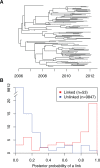Genomic Infectious Disease Epidemiology in Partially Sampled and Ongoing Outbreaks
- PMID: 28100788
- PMCID: PMC5850352
- DOI: 10.1093/molbev/msw275
Genomic Infectious Disease Epidemiology in Partially Sampled and Ongoing Outbreaks
Abstract
Genomic data are increasingly being used to understand infectious disease epidemiology. Isolates from a given outbreak are sequenced, and the patterns of shared variation are used to infer which isolates within the outbreak are most closely related to each other. Unfortunately, the phylogenetic trees typically used to represent this variation are not directly informative about who infected whom-a phylogenetic tree is not a transmission tree. However, a transmission tree can be inferred from a phylogeny while accounting for within-host genetic diversity by coloring the branches of a phylogeny according to which host those branches were in. Here we extend this approach and show that it can be applied to partially sampled and ongoing outbreaks. This requires computing the correct probability of an observed transmission tree and we herein demonstrate how to do this for a large class of epidemiological models. We also demonstrate how the branch coloring approach can incorporate a variable number of unique colors to represent unsampled intermediates in transmission chains. The resulting algorithm is a reversible jump Monte-Carlo Markov Chain, which we apply to both simulated data and real data from an outbreak of tuberculosis. By accounting for unsampled cases and an outbreak which may not have reached its end, our method is uniquely suited to use in a public health environment during real-time outbreak investigations. We implemented this transmission tree inference methodology in an R package called TransPhylo, which is freely available from https://github.com/xavierdidelot/TransPhylo.
Keywords: genomic epidemiology; infectious disease outbreak; transmission analysis.
© The Author 2017. Published by Oxford University Press on behalf of the Society for Molecular Biology and Evolution.
Figures






Similar articles
-
Genomic Epidemiology Analysis of Infectious Disease Outbreaks Using TransPhylo.Curr Protoc. 2021 Feb;1(2):e60. doi: 10.1002/cpz1.60. Curr Protoc. 2021. PMID: 33617114 Free PMC article.
-
Relating phylogenetic trees to transmission trees of infectious disease outbreaks.Genetics. 2013 Nov;195(3):1055-62. doi: 10.1534/genetics.113.154856. Epub 2013 Sep 13. Genetics. 2013. PMID: 24037268 Free PMC article.
-
Incorporating Epidemiological Data into the Genomic Analysis of Partially Sampled Infectious Disease Outbreaks.Mol Biol Evol. 2025 Apr 1;42(4):msaf083. doi: 10.1093/molbev/msaf083. Mol Biol Evol. 2025. PMID: 40256930 Free PMC article.
-
Bayesian inference of infectious disease transmission from whole-genome sequence data.Mol Biol Evol. 2014 Jul;31(7):1869-79. doi: 10.1093/molbev/msu121. Epub 2014 Apr 8. Mol Biol Evol. 2014. PMID: 24714079 Free PMC article.
-
Phylogenetic and epidemic modeling of rapidly evolving infectious diseases.Infect Genet Evol. 2011 Dec;11(8):1825-41. doi: 10.1016/j.meegid.2011.08.005. Epub 2011 Aug 31. Infect Genet Evol. 2011. PMID: 21906695 Free PMC article. Review.
Cited by
-
BlpC-mediated selfish program leads to rapid loss of Streptococcus pneumoniae clonal diversity during infection.Cell Host Microbe. 2023 Jan 11;31(1):124-134.e5. doi: 10.1016/j.chom.2022.10.015. Epub 2022 Nov 16. Cell Host Microbe. 2023. PMID: 36395758 Free PMC article.
-
Traversing missing links in the spread of HIV.Elife. 2022 Sep 30;11:e82610. doi: 10.7554/eLife.82610. Elife. 2022. PMID: 36178092 Free PMC article.
-
Inference of person-to-person transmission of COVID-19 reveals hidden super-spreading events during the early outbreak phase.Nat Commun. 2020 Oct 6;11(1):5006. doi: 10.1038/s41467-020-18836-4. Nat Commun. 2020. PMID: 33024095 Free PMC article.
-
Population-based sequencing of Mycobacterium tuberculosis reveals how current population dynamics are shaped by past epidemics.Elife. 2022 Jul 26;11:e76605. doi: 10.7554/eLife.76605. Elife. 2022. PMID: 35880398 Free PMC article.
-
Methicillin-Resistant Staphylococcus aureus Carriage among Neonate Mothers, Healthcare Workers, and Environmental Samples in Neonatal Intensive Care Units: A Systematic Review.Biomed Res Int. 2024 Apr 8;2024:5675786. doi: 10.1155/2024/5675786. eCollection 2024. Biomed Res Int. 2024. PMID: 38623471 Free PMC article.
References
-
- Anderson RM, May RM.. 1992. Infectious diseases of humans: dynamics and control. Oxford: Oxford University Press.
-
- Azarian T, Daum RS, Petty LA, Steinbeck JL, Yin Z, Nolan D, Boyle-Vavra S, Hanage WP, Salemi M, David MZ, et al. 2016. Intrahost evolution of Methicillin-resistant Staphylococcus aureus USA300 among individuals with reoccurring skin and soft-tissue infections. J Infect Dis. 214:895–905. - PMC - PubMed
-
- Becker N. 1977. Estimation for discrete time branching processes with application to epidemics. Biometrics 33:515–522. - PubMed
Publication types
MeSH terms
Grants and funding
LinkOut - more resources
Full Text Sources
Other Literature Sources
Medical

